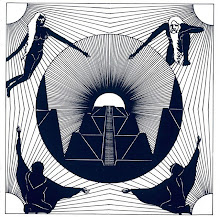
This following introduction to this album is really interesting and sets all the prerequisites that you need to meet before you listen to this album. It end up being an exceptional experience. I also wanted to share this album for David, a long time friend, whose blog [clubmoustache] got me more interested in electronic music and especially its birth (to which this album greatly contributed).
" This is the kind of record that very few people know about, but it’s understatement to say that theyshould know about it. If you haven’t heard that record, I seriously doubt you should consider yourself a fan of electronic music, yet. Compared to its German luminaries such as Kraftwerk or Can, it’s just as historically important. Then we could say it’s quite underrated indeed. First, let’s mention that Manuel Göttsching was part of Ashra Tempel with Klaus Schulze, and they even made an album with the late Timothy Leary. He is one of the most important guitarists of the Kosmische Musik genre. He also participated in the Cosmic Jokers sessions. His style and technique influenced dozens of artists in the post-Eno ambient and new age scenes in the 1980s and 1990s. But let’s face it, even though that record is a classic and has influenced everyone in the Detroit techno area from Carl Craig to Derrick May, rarely will you sit still 58 minutes to listen to an entire record which consists of just one track. It takes time, in fact, it is time consuming. It also takes patience. If you don’t like stuff like Brian Eno or Tangerine dream, Steve Reich and minimalist music then this record is not made for you. But then again, you would miss on something which is quite a masterpiece. The first time, I heard it was in 1998 I think, close to 15 years after its release. Now on to 25 years after its original production, it has aged especially well. Sure, back then it was picked by one of the best DJ’s of all time in Larry Levan who used to mix it next to the Clash. But think about it : this record has been covered in 1989 by the Italian techno-house outfit Sueno Latino, it was covered by Basic channel,on their Basic reshape, and remixed by Paperclip people aka Carl Craig on his Remake uno EP. Most recently it was picked by LCD Soundsystem‘ on 45:33 a record that was inspired by E2 E4 both conceptually as seen on the artwork and musically with the duration of the song. Just another example of how many times it’s been named-checked, reworked and expanded countless times.
E2-E4, was released in 1984, and was the first solo recording album by Manuel Göttsching. The album itself consists of a minimalistic hour-long progressive electronic track that is subdivided into single tracks according to the stage of the song. The second half of the record is notable for Göttsching’s guitar playing. The album is named after the most popular opening chess move, 1. e4. Maybe its legendary status is due to the fact that as the story is sometimes told, Göttsching stopped in the studio, while touring with Klaus Schulze, and invented techno. In a concert mood, in december (that would put this record 30 years old ) of 1981, he entered his studio armed with only a korg synth and a guitar, his favorite asset. And then, he started playing. He improvised. But thanks for us, he decided to record the whole thing on the spur of the moment. And an hour of music was born. But he did not even intend to release it. After much reflections, doubts and afterthoughts, and only after the counsel of usual pal Schulze and especially three years later, he decides to publish the session. E2 E4, covered with a chessboard on cold and brown, sees the light and its light changes the course of history. E2 E4 is the most compelling argument that techno came from Germany. And even more so than any Kraftwerk album, anyway. Over a heavenly two-chord synth vamp and simple sequenced drum and bass, Göttsching’s played his guitar like a percussion instrument, creating music that defines the word hypnotic over the sixty minutes of the single track.
How do we explain musical genius ? We can’t. When it happens, it just happens. And nothing happens at random, this for both normal and special things. But only the special things happen by pure magic, or some strange astral combination, the dance in zero gravity between relevant things and transcendent randomness, that leads to improvisation. The ability to take a theme and stretch it out into an ever increasing artform is often unattainable. The ex-leader of Ashra, the kraut-deutsch guru Manuel Göttsching, did it a quarter century ago, and his ability came from live shows. But what’s E2 E4 ? For a human, the easiest opening move in chess. For a musician, the dream of life. A persistent pulse of dreamy synthethic geometries which proceeds to the nirvana escorted by a spastic beat and a guitar that never ceases to peak. A perfect loop, the loop by definition. Nevertheless it’s not a dance piece. But it’s impossible to speak of E2 E4 in terms of human technology, if you’ve got that melody in your head, it will never leave you. I will never grow tired of that record. Jeff Mills once said : some things are better left unexplained. I do agree with him. That is the case with E2 E4. " funkyjeff77, from http://funkyjeff77.wordpress.com/
I cut the song in multiple parts, corresponding to the different variations, and left the song itself (59 minutes),at the end. Enjoy!


Je viens juste de le voir ! Je suis déjà en train d'écouter l'album à vrai dire.
ReplyDeleteMerci David.
This comment has been removed by the author.
ReplyDelete